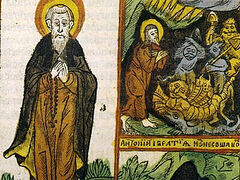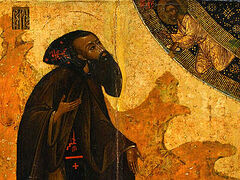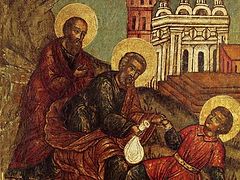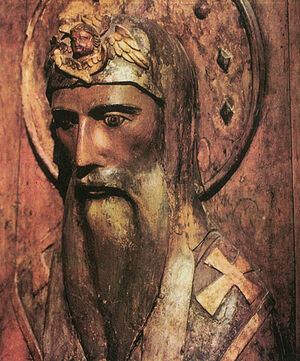 St. Theognost, Metropolitan of Kiev and All Russia. Wood (linden), gesso, egg tempera, carving, gesso carving, gesso embossing. Late 17th c. It is amazing how little we often know what our happiness is. It seems to us that we desperately need something, and without it, everything will collapse and fall apart. And the Lord gives us something completely different, something we don’t want, which according to human logic can only ruin our (often very good) dreams… But time will pass, and, having come to terms with these “unfavorable” circumstances, we realize that it was through them that our happiness was built. And God forbid what would have happened if we had arranged everything according to our own desires… Truly, “He also arranges our salvation through things that seem to be against us”, as the Venerable Leo (in schema: Leonid) of Optina said.
St. Theognost, Metropolitan of Kiev and All Russia. Wood (linden), gesso, egg tempera, carving, gesso carving, gesso embossing. Late 17th c. It is amazing how little we often know what our happiness is. It seems to us that we desperately need something, and without it, everything will collapse and fall apart. And the Lord gives us something completely different, something we don’t want, which according to human logic can only ruin our (often very good) dreams… But time will pass, and, having come to terms with these “unfavorable” circumstances, we realize that it was through them that our happiness was built. And God forbid what would have happened if we had arranged everything according to our own desires… Truly, “He also arranges our salvation through things that seem to be against us”, as the Venerable Leo (in schema: Leonid) of Optina said.
This often happens in our lives, and always will. And this also happened back in 1328, when instead of Archimandrite Theodore, the favorite candidate of Grand Prince Ivan I Kalita (1325–1340) and the holy Metropolitan Peter, the Greek Theognost (Theognostos) was consecrated in Constantinople as Metropolitan of Kiev—St. Peter’s successor to the Metropolia of All Russia. It would seem that a Greek could hardly understand the difficulties of a foreign country such as Russia. Indeed, those were tough, if not critical, times when the great hierarch Peter was putting all his energy into unifying the Russian lands and supporting Moscow and its prince, through whom, as he foresaw, Russia would grow stronger and flourish. Was it the business of a native of Constantinople (appointed in place of a Russian candidate due to Constantinople’s desire “to maintain control over the richest metropolia of the Patriarchate of Constantinople, which at that time supported not only the Patriarchate, but also the imperial court”!1) to decide which city the Russian lands would unite around, and whether they would unite at all… Human logic tells it that it wouldn’t be. But great are the works of the Lord; not only did Metropolitan Theognost understand all the subtleties of Russia’s state of affairs, he sincerely accepted this country as his own, devoting the rest of his life to his new homeland, developing and strengthening it, sparing neither his energy nor his health. Not even the prospect of tortures by the Golden Horde could stop him. And how surprisingly vital for our Church was the genuinely “Roman” (as the Byzantines identified themselves) Eastern diplomacy (or it could be said, remarkable political resourcefulness), the connections, zeal, statesmanship, and excellent spiritual education of its new Primate! We believe that only such a figure could (and did!) turn the small and modest Moscow of that time into a beautiful and influential city, thoroughly conceiving the strikingly multi-faceted policy of its rise, taking all the nuances into account and leaving absolutely nothing for himself. The Life of St. Theognost does not contain amazing accounts of miracles like that of St. Alexei, nor is there any great fame like in St. Peter’s. In his Life, there is only his unceasing, selfless work for the benefit of the Russian Church, to which he was related not by blood, but by Christian love. Isn’t that a miracle in itself?
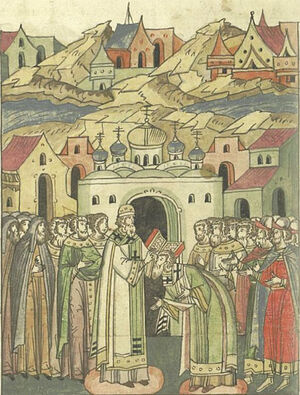 The consecration of St. Theognost as Metropolitan of All Russia by Patriarch Isaias. 16th c. illuminated chronicles. Russian History in Chronicles. Book 7. 1290-1342. Illustration: Runivers.ru According to available sources, St. Theognost was born in Constantinople, received a good education, “acquired knowledge of the Divine canons and laws, proved himself to be a reasonable and God-loving man, and was regarded as an adornment of his native city.”2 However, this is almost all that we know about his life until the moment in 1328 when Patriarch Isaias of Constantinople consecrated him as Metropolitan of Kiev and All Russia.
The consecration of St. Theognost as Metropolitan of All Russia by Patriarch Isaias. 16th c. illuminated chronicles. Russian History in Chronicles. Book 7. 1290-1342. Illustration: Runivers.ru According to available sources, St. Theognost was born in Constantinople, received a good education, “acquired knowledge of the Divine canons and laws, proved himself to be a reasonable and God-loving man, and was regarded as an adornment of his native city.”2 However, this is almost all that we know about his life until the moment in 1328 when Patriarch Isaias of Constantinople consecrated him as Metropolitan of Kiev and All Russia.
As mentioned above, Moscow was not enthusiastic about his appointment, but Grand Prince Ivan Kalita, an intelligent and good politician, decided not to quarrel with the new metropolitan because of this, but on the contrary to accept him very benevolently and try to turn such an unfavorable circumstance to Russia’s benefit.
Having visited the Galician and Volhynian lands and installed two bishops there, Metropolitan Theognost arrived in Vladimir—then (formally) the capital of Russia, and from there soon to Moscow. Obviously, the desire for peaceful and even friendly relations on the part of Ivan Kalita was mutual from the very beginning, because Metropolitan Theognost remained in Moscow, and took up residence in the house of the late St. Peter, beginning to rule the metropolia from there.
Having settled down in his new country, St. Theognost quickly entered into its life. He took the veneration of his predecessor, Metropolitan Peter, very seriously and reverently. Having learned from eyewitnesses the details of his hard-working, ascetic life, he saw national veneration of him as a saint and miracles occurring at his relics. He began to prepare for his canonization. The canonization could have taken place right in Russia, as a metropolitan's authority would have allowed Metropolitan Theognost to do so. However, inspired by the significance of the holy archpastor’s work for the unification of the Russian lands, St. Theognost decided to arrange his canonization with all possible solemnity, appealing to Constantinople. In 1339 he received a message from Patriarch John XIV Kalekas, granting his blessing for St. Peter’s canonization. Such an exceptional solemnity (canonizations of Russian saints had been much more modest up to that point) undoubtedly benefited Moscow. This is because, among other things, St. Peter was the first metropolitan to move to Moscow, and in such a rapid and grand canonization everyone “could see a clear sign of God’s special favor for Moscow, which would have an exceptional destiny.”3
But St. Theognost did not stop there. He understood perfectly well that a city claiming to be the capital of a state in the near future should outwardly correspond to such a title. Meanwhile, at that time there were virtually no stone churches in Moscow; even the Moscow Kremlin was wooden. You can imagine the contrast with the splendor of Metropolitan Theognost’s native Constantinople. So the saint set to work vigorously, explaining the need for construction work to Grand Prince Ivan. In the second year of St. Theognost’s tenure as metropolitan, the stone churches of St. John Climacus (later the Great Bell Tower would appear in its place) and of Apostle Peter were built. “In the following year of 1330, the Grand Prince laid the foundation of the third stone church dedicated to the Savior in his house or court Monastery.4 “The Church of the Savior on the Pine Woods”; and four years later, the famous Cathedral of the holy Archangel Michael was built.
The holy hierarch pastored other dioceses of Russia as well. He traveled extensively, especially to the country’s major cities. Such “archpastoral trips were perceived as an integral part of a metropolitan’s ministry.”5 St. Theognost visited Bryansk, Kostroma, and Volhynia; he visited Novgorod twice, although the freedom-loving city, sensing the Primate’s support for Moscow and foreseeing this as an infringement of its own freedom, did not give the Metropolitan a very cordial welcome.
There was another very important condition for the revival of Russia under the Mongol Horde, to which the wise archpastor gave considerable attention. This condition was ownership of church land. It sounds rather strange on its face, but the fact is that according to the law code issued by Genghis Khan (the famous “Yassa”), clergy of any faith were not to be oppressed by the Mongols, and their estates were not taxed. Therefore, lands belonging to the Church greatly multiplied (along with the people attached to these lands). The Metropolitan increased the number of people who paid no tribute to the overlords, and he thus accumulated strength and resources inside Russia. But for those dissatisfied with Ivan Kalita it became an excuse to accuse St. Theognost, who supported the Grand Prince, of avarice. And not just to accuse him, but also to inform Janibek Khan about it: “The Metropolitan collects huge funds from his lands, but pays you, the Khan, nothing! Make him pay tribute also…”
It is sad, very sad to talk about this. In these petty squabbles, seeking individual fame and greatness, we had already lost Ancient Russia, a very beautiful country, and countless kinsmen. For the greater good of their country, they should have come to their senses, forgotten their petty desires, and repented of the deaths of innocent people! But no—again, they wanted their own way by any means, and they were not afraid to set a common enemy against their fellow countrymen, even against the Church and its primate.
Janibek Khan, who had just ascended the throne, summoned the saint to the Horde together with the young Grand Prince Simeon the Proud (Ivan Kalita’s son and successor; 1340–1353). He sent the prince back quickly, but upon hearing such denunciations, detained the holy Metropolitan. Persuasion, threats and even torture followed: The Horde wanted to force Metropolitan Theognost to agree to pay tribute himself at all cost, since they knew perfectly well that Genghis Khan’s “Yassa” provided special rights to clergy and they were afraid to violate them. But the saint stood his ground firmly. “There will be no tribute from the church lands,” he declared. He was ready to give all his money (and indeed he gave 600 rubles—an enormous sum at that time!), and endured everything, but he did not allow them to rob Russia and its people, his flock.
Finally, the Mongols gave up. It took all the Metropolitan’s “diplomatic talent and purely Byzantine resourcefulness”6 and genuinely Christian self–sacrifice, but in the end, Janibek Khan released St. Theognost, giving him a label confirming the former Church rights. A label was also given to the Metropolitan by Janibek’s wife, Taydula Khatun, who would many years later be healed by St. Theognost’s successor, Holy Hierarch Alexei…
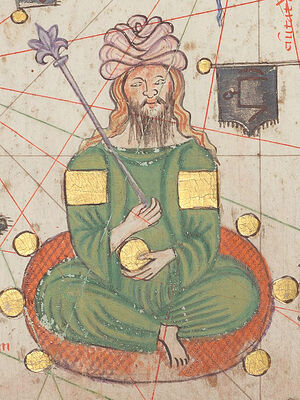 Symbolic portrait of Janibek Khan in the Catalan Atlas (1375) The question of the Western metropolias located on the territory of the Grand Duchy of Lithuania caused St. Theognost much trouble; these were Russian lands with Russian populations, which had fallen into political dependence on the Grand Duchy of Lithuania during tough times in the thirteenth century. The rulers of Lithuania naturally continually tried to separate “their” lands from Russia spiritually, as well as geographically. In other words, they wanted to establish their own metropolia. For this purpose, many petitions and large sums of money were sent to Constantinople. At the very beginning of his tenure, St. Theognost abolished the Metropolia of Lithuania, but only a few years had passed when again “Metropolitan Theodore of Galicia [i.e. of the separated Western Russia.—Auth.] put his signature under the acts of the Patriarchate of Constantinople.”7 St. Theognost traveled to the western lands, confirmed his jurisdiction, and with the participation of almost all the bishops of Western Russia, consecrated bishops for Novgorod and Tver. He immediately sent envoys to Constantinople, demanding the abolition of the illegally established Galician Metropolia. He went there himself, and in 1332 he finally personally secured the illegal metropolia’s dissolution in Constantinople. But fifteen years later the whole affair was repeated, and once again Metropolitan Theognost had to make great efforts to settle the turmoil in the Church…
Symbolic portrait of Janibek Khan in the Catalan Atlas (1375) The question of the Western metropolias located on the territory of the Grand Duchy of Lithuania caused St. Theognost much trouble; these were Russian lands with Russian populations, which had fallen into political dependence on the Grand Duchy of Lithuania during tough times in the thirteenth century. The rulers of Lithuania naturally continually tried to separate “their” lands from Russia spiritually, as well as geographically. In other words, they wanted to establish their own metropolia. For this purpose, many petitions and large sums of money were sent to Constantinople. At the very beginning of his tenure, St. Theognost abolished the Metropolia of Lithuania, but only a few years had passed when again “Metropolitan Theodore of Galicia [i.e. of the separated Western Russia.—Auth.] put his signature under the acts of the Patriarchate of Constantinople.”7 St. Theognost traveled to the western lands, confirmed his jurisdiction, and with the participation of almost all the bishops of Western Russia, consecrated bishops for Novgorod and Tver. He immediately sent envoys to Constantinople, demanding the abolition of the illegally established Galician Metropolia. He went there himself, and in 1332 he finally personally secured the illegal metropolia’s dissolution in Constantinople. But fifteen years later the whole affair was repeated, and once again Metropolitan Theognost had to make great efforts to settle the turmoil in the Church…
In the holy archpastor's final years, there was an outrageous incident. A certain monk, Theodoret, came to Constantinople declaring that Metropolitan Theognost was dead and laying claims to his throne. When the Patriarch of Constantinople did not believe him, Theodoret fled to Bulgaria and there... was appointed Metropolitan of Kiev and All Russia by the Patriarch of Bulgaria. Of course, such a blatant violation of the canons was strongly condemned by both Constantinople and Russia. Theodoret only lasted a year in Kiev, backed by Grand Duke Algirdas of Lithuania, who dreamed of a separate metropolia. Shortly before his repose, St. Theognost appointed Holy Hierarch Alexei, our greatly beloved saint, as his successor, and sent a petition to Constantinople to confirm his appointment.
Thus, the whole life of Holy Hierarch Theognost, a wonderful metropolitan, a true Christian, and, I will say, a patriot of the Church, was spent in selfless labors for the benefit of the Church. He was engaged in political affairs, but only for the good of his flock, sparing neither possessions nor his own life to serve Christ. He fell asleep in the Lord on March 11, 1353, during a plague and was buried next to the tomb of the Holy Hierarch Peter, whom he had canonized.

